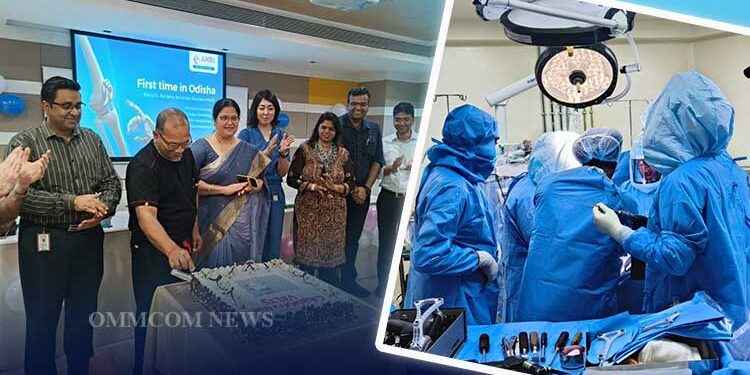Bhubaneswar: Our knees are hardworking joints. While we are walking, crouching, or even standing still, our knee depends on a well-tuned system of bones, ligaments, cartilage, muscles, and nerves. If an injury, arthritis, or another condition affects any of the parts of your knee, you may need knee replacement surgery.
Precision is vital in these procedures. The more exact a surgeon’s measurement tools, the better they can plan and perform your surgery. Robotic knee replacement technology ensures that surgeons can undertake successful knee replacement surgeries with precision and in less time.
The success of the surgeons at the AMRI Hospitals in Bhubaneswar bears testimony to this.
Dr Sunil Das, a leading orthopaedic surgeon in Odisha who is leading the Robotic Knee Replacement Process at the Bhubaneswar AMRI Hospitals, said, “It is a great feeling today. With the blessings of the Almighty, we have started robotics-assisted total knee replacement at AMRI hospital Bhubaneswar and completed three knee surgeries successfully. I am very much thankful to my operation theatre and support staff. Hope with this new technology I will be able to give better results to my knee replacement patients.”
What is Robotic Knee Replacement?
A robotic knee replacement is similar to a traditional knee replacement. Your surgeon removes damaged tissue in your knee and replaces it with an artificial joint. The difference is that it’s done with assistance from a robotic arm or handheld robotic.
Robotic-assisted procedures allow for greater precision and can lead to shorter recovery times and better results. In more complex cases, a robotic-assisted knee replacement offers a better balance in the soft tissues around your knee, and better aligns the joint. If you’re having a robotic-assisted knee replacement surgery, you don’t have to prepare any differently than you would for conventional surgery.
Who can opt for robotic knee replacement?
If you are a candidate for traditional knee replacement, it is likely you are a candidate for robotic-assisted knee replacement, as well. Robotic knee replacements are ideal for even the most complex knee joint disease, including patients having
- Deformities in the femur after an injury
- Complex degeneration
- Hardware from previous surgeries
- Ligament-Sparing Options
The knee’s four ligaments contain special nerves that send the brain information about how your leg is moving and its position in space. This helps your body with movement, acceleration, balance, and more.
In a conventional knee replacement surgery, one or two of these ligaments must be removed. While this doesn’t impact pain after surgery, it can impact how an artificial knee feels after recovery.
A small number of orthopaedic surgeons can perform traditional knee replacement surgeries that preserve all four ligaments. With the added precision and accuracy of the robotic-assisted knee replacement system, however, this type of surgery is available to more patients than ever before.
Benefits of Robotic Knee Replacement Surgery
Enhanced surgical planning: Depending on the robotic option that is right for you, specialized 3D images are taken in preparation for or during surgery. These images help your surgeon more accurately plan the optimal type and placement of your replacement joint to ensure the right size and fit.
Greater precision: Robotic technologies enhance your orthopaedic surgeon’s expertise for more precise planning, tissue removal and implant placement. This can cause faster recovery times, fewer complications and a lower likelihood of revision surgery.
More ligament-sparing options: With the added precision and accuracy of the robotic-assisted knee replacement system, ligament-sparing total knee replacement surgery is available to more patients than ever before.
Traditional vs. Robotic Surgery for Knee Replacements
Robotic-assisted knee replacement surgery is not done by a robot alone. Instead, it acts as a guide, helping your surgeon follow the plan laid out in advance.
Like during traditional surgery, your orthopaedic surgeon is in control, however, they use the robot as an additional surgical tool. The robot enhances your surgeon’s skills during all stages of your surgery to help deliver the best possible outcomes.
Robotic Knee Replacement Recovery Process
Robotic joint replacement uses more precise incisions and helps achieve optimal positioning, which may lead to a better and faster recovery and offer better satisfaction. Overall, people who have undergone robotic knee replacement surgery have experienced lesser recovery time, less pain and elevated satisfaction compared to the traditional knee replacement surgery process.
After your surgery, your surgeon and the rest of your care team will monitor your progress, help to relieve discomfort and chart a course for your at-home recovery. Learn what to expect during recovery and rehabilitation after knee replacement surgery, including pain management.
(This article was written based on inputs provided by AMRI Hospitals, Bhubaneswar.)















